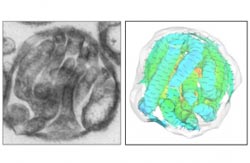Multi-disciplinary Penn Research Identifies Protein Required for Cell Movement

An electron microscope (left) and mathematical simulations (right) show Exo70-induced membrane reshaping.<br>
Cells must be mobile in order for organisms to grow, to heal, to transmit information internally, to mount immune responses and to conduct a host of other activities necessary for survival. But if cell mobility is unregulated, tumors can grow and spread throughout the body.
A new multi-disciplinary study by University of Pennsylvania researchers has now illuminated a crucial step in the process of cell movement. The protein they examined, Exo70, induces a reshaping of the cell’s plasma membrane, a necessary step in how a cell migrates from one location to another.
The findings deepen the understanding of how cells initiate movement, and they have implications for conditions dependent on cell migration, including cancer.
The research, published in the journal Developmental Cell, was co-led by graduate students Yuting Zhao and Jianglan Liu, both members of senior author Wei Guo’s lab in Penn’s School of Arts and Sciences’ Department of Biology. Liu is now a postdoctoral fellow at the Wistar Institute. The work involved a collaboration with researchers at Penn’s Perelman School of Medicine and School of Engineering and Applied Science.
Previous research on cell migration had focused on actin, a protein that forms filaments and branches and is known to play a role in a variety of activities, including those that involve remodeling a cell’s shape. But Guo and other scientists believed there had to be other factors aiding the reshaping of cellular membranes.
“The plasma membrane is not a rubber band,” Guo said. “It’s hard to imagine actin just pushing it to change its shape. There had to be a mechanism to accommodate the actin, otherwise the membrane would be ruptured.”
That’s when Guo’s team thought of Exo70. His lab is focused on exocytosis, or the organized process by which cells carry proteins to the membrane in vesicles and then release important molecules such as hormones and neurotransmitters to travel elsewhere in the body. A structure made up several proteins, called the exocyst, helps mediate this process. Previous work by Guo and colleagues found that the exocyst is also involved in cell migration. Last year his lab published a paper, also with Liu and Zhao as lead authors, showing that Exo70, a component of the exocyst, stimulates actin structural changes at the leading edge of migrating cells.
In the current study, Zhao, Liu, Guo and colleagues wanted to more deeply examine what Exo70 was doing in the cell and how it was doing it. Using electron microscopy, they first found that Exo70 “bends” the membranes to generate high-curvature tubules. In addition, the presence of Exo70 in cells led to the creation of protrusions on the membranes. They also found that Exo70 formed complexes of at least two copies of the protein, known as oliogmers.
Using mathematical models, the researchers teamed with Ravi Radhakrishnan’s group in Penn Engineering to study how the curvature of these protrusions formed. They confirmed that their simulations matched up with what they were observing Exo70 do under the microscope.
Then, using time-lapse microscopy, they found that Exo70 generated protrusions in the membrane that were later filled with actin.
“We call it the empty glove,” Guo said. “Exo70 is the glove, and actin acts like fingers that push in and fill the empty pockets.”
Exo70 proteins that were mutated so they couldn’t form oligomers were unable to effectively migrate, the researchers discovered, underscoring the importance of the molecule in helping cells make directed movements.
“This gives us a new understanding of the mechanism of cell migration,” Guo said. “Studies in the field have been very much focused on actin, but our findings emphasize the importance of the membrane component in cell motility.”
Guo and colleagues are pursuing further studies of Exo70 to consider a possible role for it in the uncontrolled growth and metastasis seen in many forms of cancer.
Three of Penn’s schools, including five different departments, collaborated on this publication.
Additional authors in the School of Arts and Sciences included Changson Yang and Tatyana Svitkina of the Department of Biology and Benjamin R. Capraro and Tobias Baumgart of the Department of Chemistry. The School of Engineering and Applied Science’s Ryan P. Bradley of the Department of Chemical and Biomolecular Engineering, N. Ramakrishnan of the Department of Bioengineering and Ravi Radhakrishnan, who has affiliations in both departments, contributed. And Xiaowei Xu from the Perelman School of Medicine’s Department of Pathology and Laboratory Medicine was also a coauthor.
The research was supported by the National Institutes of Health.
Media Contact
More Information:
http://www.upenn.eduAll latest news from the category: Interdisciplinary Research
News and developments from the field of interdisciplinary research.
Among other topics, you can find stimulating reports and articles related to microsystems, emotions research, futures research and stratospheric research.
Newest articles

NASA: Mystery of life’s handedness deepens
The mystery of why life uses molecules with specific orientations has deepened with a NASA-funded discovery that RNA — a key molecule thought to have potentially held the instructions for…

What are the effects of historic lithium mining on water quality?
Study reveals low levels of common contaminants but high levels of other elements in waters associated with an abandoned lithium mine. Lithium ore and mining waste from a historic lithium…

Quantum-inspired design boosts efficiency of heat-to-electricity conversion
Rice engineers take unconventional route to improving thermophotovoltaic systems. Researchers at Rice University have found a new way to improve a key element of thermophotovoltaic (TPV) systems, which convert heat…



